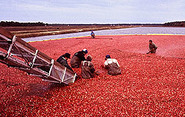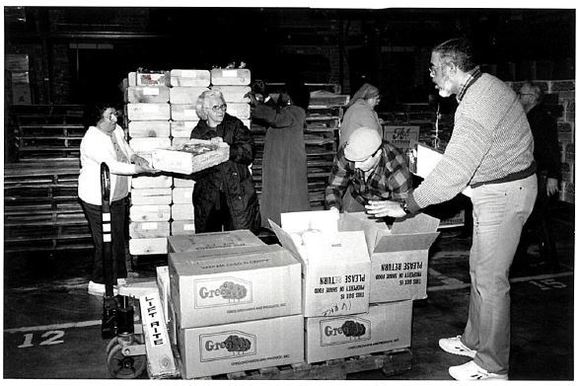|
The USDA Food and Nutrition Service's Food Distribution Division launched new "USDA Foods from Farm to Plate" e-letters in February 2015! We will be sharing resources, news, and best practices for all of our programs, including this special "Household Highlights" update focusing on the Commodity Supplemental Food Program (CSFP) and The Emergency Food Assistance Program (TEFAP). Other editions will feature the Food Distribution Program on Indian Reservations (FDPIR)and the National School Lunch Program (NSLP) and other child nutrition programs. Visit the FNS website to sign up to receive these e-letters via GovDelivery or modify your subscription preferences (see instructions below). We welcome your input on topics for future letters, and you may contact us through our USDA Foods mailbox at USDAFoods@fns.usda.gov.
TEFAP, a program that serves food insecure individuals and households through food banks, soup kitchens, and other charitable and emergency feeding organizations, has added several new products to its entitlement ordering catalog! States may now order fresh russet potatoes and fresh round white potatoes, both in five pound bags, as well as fresh apples and pears in three pound packages. Based on interest in more items suitable for backpack programs, TEFAP also now offers 1% shelf-stable milk in smaller, 8 oz. containers. Rounding out the list of new products are reduced fat cheese, in two pound loaves as in CSFP; frozen, unbreaded catfish fillets; and kosher salmon, which was added last spring.
 Bonus foods purchased through the Agricultural Marketing Service's market support program supplement the USDA Foods obtained through traditional entitlement orders. Fiscal Year (FY) 2015 bonus buys thus far include over $3 million in frozen carrots and $55 million in cranberries (dried cranberries, cranberry sauce, and cranberry juice concentrate). States were also offered the opportunity in recent months to order $10 million in grapefruit juice, $40 million in cherries (dried and/or frozen), and $7 million in grape juice.
Do you have an idea for a new food you would like to see in TEFAP? Please send your feedback to USDAFoods@fns.usda.gov.
Photo: Cranberry harvest. USDA photo by Keith Weller.
|
Food banks and State agencies from Arizona to Maine are finding creative ways to provide fresh produce and proteins to the individuals and households they serve, supplementing the options available through TEFAP and CSFP.
The Nogales Community Food Bank of Southern Arizona, located near the United States - Mexico border, is taking advantage of a U.S. Food Waste Challenge program that matches importers of certain fruits, vegetables, and nuts with charitable organizations. When wholesome, fresh produce is not able to enter the supply chain to the planned destination for a variety of reasons, the donation program innovatively supports two USDA missions: increasing access to healthy food and reducing food waste. Learn more about this Agricultural Marketing Service program and the FV-6 exemption for charitable organizations by visiting the "Donate Imported Produce to U.S. Food Banks" webpage.
 The Maine Department of Agriculture, Conservation and Forestry, which administers TEFAP and CSFP, has a garden behind its building which provides seasonal vegetables for distribution to individuals who may also be receiving CSFP and TEFAP benefits. In FY 2014, Cony Gardens, in conjunction with the Kennebec County Sheriff’s Office, shared 68,970 pounds of tomatoes, butternut squash, potatoes, and zucchini with food pantries, shelters, soup kitchens, and CSFP distribution locations. Additional protein options arrive through a partnership between the Maine Department of Agriculture and the Department of Inland Fisheries and Wildlife. In FY 2014, Hunters for the Hungry shared 5,200 pounds of processed moose, deer, and bear with food pantries, shelters, and soup kitchens affiliated with TEFAP. One entrepreneurial official has even obtained fish from ice fishing contestants with catches in excess of the licensed limit, and the fish was then processed for individuals in need.
|
The Agricultural Marketing Service has updated labeling requirements for USDA Foods canned fruits, vegetables, and dried beans to improve the image of the high quality, nutritious foods distributed to federal food and nutrition assistance program recipients, including food banks, soup kitchens, and other community organizations. Suppliers have the option to use commercial labels or USDA's "America's Finest" labels. New requirements mandate that commercial labels for USDA Foods canned fruits, vegetables, and dried beans must include, at a minimum, two colors in addition to black and white and must incorporate a graphic (photo or illustration) depicting the product/contents on the principal display panel.
Welcome New CSFP States!
On December 16, 2014, President Obama signed the
Consolidated and Further Continuing Appropriations Act, 2015, which provided
$211.482 million for CSFP, including $2.8 million designated for States with
approved State plans but not currently participating in CSFP – Connecticut, Florida,
Hawaii, Idaho, Maryland, Massachusetts, and Rhode Island. FNS issued a
final caseload allocation of 604,000 slots nationwide, which included 16,000
slots for the seven new States. More details about the 2015 caseload allocation,
including the specific level assigned to each of our new States, is included in
the 2015
CSFP Final Caseload and Administrative Funding memorandum, available on the
CSFP
homepage. FNS recently held an orientation in Alexandria, Virginia for the
new States authorized to participate in CSFP beginning in FY 2015, providing
them with valuable information on how to get their programs up and running.
The orientation was attended by representatives from all new
States, and was well received.
CSFP Transitions to a Seniors-Only Program
Section 4102 of the Agricultural Act of 2014 (P.L. 113-79,
the Farm Bill) amended CSFP’s eligibility requirements to phase out the
participation of women, infants, and children and transition CSFP to a
seniors-only program. No women, infants, or children are eligible for
enrollment in new CSFP States. Currently participating States are
responsible for ensuring that no new applications for women, infants, or
children are approved, and that only women and children eligible under Section
4102 of the Farm Bill are currently receiving CSFP benefits. Under the
regulations, as infants are considered to be children when they reach one year
of age and it has been over a year since Farm Bill-required implementation of the
phase-out, there should be no further infants on the program at this time.
Any women, infants, or children seeking to apply for CSFP benefits should be
referred to the Special Supplemental Nutrition Program for Women, Infants, and
Children (WIC), the Supplemental Nutrition Assistance Program (SNAP), and other
nutrition assistance programs for which they may be eligible. For
further information, please see the CSFP
Final Rule.
CSFP
Inventory Calculator Available!
The
optional CSFP
inventory calculator is a convenient tool for State agency staff to check
inventory levels now and in the future to ensure that each food package
category is as close as possible to the recommended two to two-and-one-half
months on-hand. Close monitoring of these levels allows FNS to stretch
limited food dollars for the program and ensure recipients receive full food packages.
TEFAP
Food Funds Carryover
The Farm Bill also provides that TEFAP funds for food
purchases are made available for two Fiscal Years which allows USDA to carryover each
State’s unexpended balance to the next FY. FNS issued an implementation
memorandum describing the TEFAP carryover provision to State agencies and
is drafting regulations defining requirements for this provision as well.
Beginning this FY, each TEFAP State will be able to keep any remaining TEFAP food
entitlement balance at the end of a FY and place orders against it during the
subsequent FY. Webinars to discuss this Farm Bill provision
and the application of it from a food ordering standpoint are planned for FNS Regional Office staff in late April and State Agency staff in May.
7
CFR Part 250 Final Rule Under Development
FNS is working on a final rule entitled “Requirements for the Distribution and Control
of Donated Foods,” which would revise 7 CFR Part 250, our overarching
regulation which applies to USDA Foods in CSFP, FDPIR, TEFAP, and Child
Nutrition Programs. This rule will (1) revise and clarify
requirements to ensure that USDA Foods are distributed, stored, and managed in
the safest, most efficient, and cost-effective manner at State and recipient agency levels, (2) reduce administrative and
reporting requirements for States, (3) revise and clarify regulations relating to the accountability of donated foods, and (4) rewrite much of 7 CFR Part 250 in a
more user-friendly, plain language format. There was a 90-day public comment period on the
proposed rule, which ended on January 20, 2015. We are incorporating
comments received to the extent feasible and will provide more details on the rule once it is available.
 In this photo from the Food Distribution archives, SHARE director of research and development Deacon Joshua Alves assists volunteers in stacking food packages on distribution day. For 80 years, USDA has provided food assistance to support farmers and promote nutrition and food security, with the Needy Family Program serving as a precursor to CSFP (1973) and TEFAP (1981).
FNS staff will be participating in these upcoming meetings. We look forward to these opportunities to meet you and hope to see you there!
May 3-5: American Commodity Distribution Association (ACDA) Annual Conference in Salt Lake City, Utah. USDA staff will be among the presenters, with session topics including procurement, inventory management, and other program, regulatory, and legislative updates.
May 21: 5th Annual Southeast Regional Office USDA/State Agency/Food Bank Conference in Atlanta, Georgia
 Here's how to sign up for these updates via GovDelivery:
1. Go to the FNS website: http://www.fns.usda.gov/fdd/food-distribution-programs
2. Click on the red envelope on the row of social media icons on the top right of the page.
3. Enter your email address and click "Submit."
4. Check the boxes to select your topics of interest. For these e-letters, scroll down to the Food Distribution category and click the plus sign to the left of the check box to expand the list and view all the sub-categories. Check these sub-categories to receive the corresponding e-letters:
*USDA Foods --> receive all "USDA Foods from Farm to Plate" general + program-specific e-letters
*Commodity Supplemental Food Program (CSFP) --> receive "Household Highlights" e-letter
*The Emergency Food Assistance Program (TEFAP) --> receive "Household Highlights" e-letter
*Food Distribution Program on Indian Reservations (FDPIR) --> receive "FDPIR Connection" e-letter
*Schools/Child Nutrition Commodity Programs --> receive "Spotlight on Schools" e-letter
5. Update your subscription preferences any time by following the above steps or clicking on the Subscriber Preferences Page link at the bottom of any of the e-letter email messages you receive from GovDelivery. Questions? Contact us at USDAFoods@fns.usda.gov
|
|